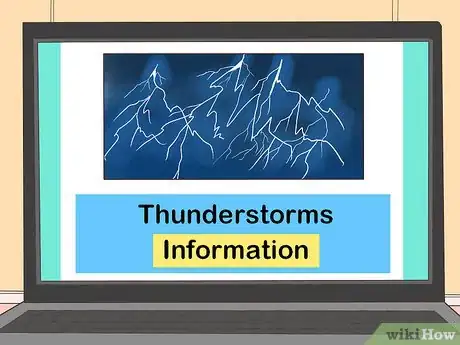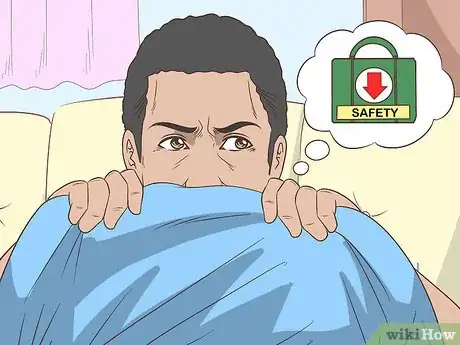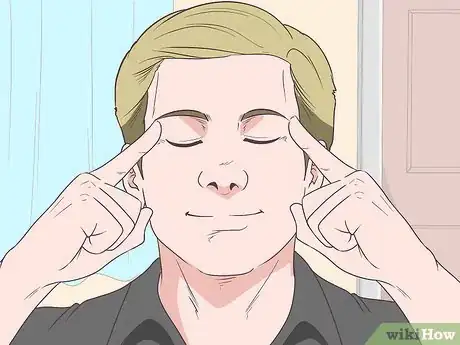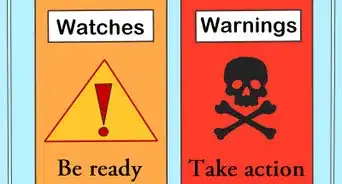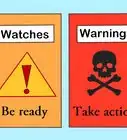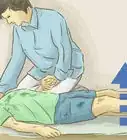This article was co-authored by Alex Dimitriu, MD. Alex Dimitriu, MD is the Owner of Menlo Park Psychiatry and Sleep Medicine, a clinic based in the San Francisco Bay Area with expertise in psychiatry, sleep, and transformational therapy. Alex earned his Doctor of Medicine from Stony Brook University in 2005 and graduated from the Stanford University School of Medicine's Sleep Medicine Residency Program in 2010. Professionally, Alex has dual board certification in psychiatry and sleep medicine.
wikiHow marks an article as reader-approved once it receives enough positive feedback. This article received 13 testimonials and 80% of readers who voted found it helpful, earning it our reader-approved status.
This article has been viewed 163,685 times.
Flash! Crash! Boom! A thunderstorm is coming. How are you supposed to fall asleep with all of that racket, much less sleep soundly? How can you block out the sound and light? In some parts of the country, frequent storms can be a frequent sleep disruptor. However, you can take certain precautions to ensure that you’ll be able to drift off no matter what is happening in the heavens. It just takes a bit of planning and ingenuity.
Steps
Staying Calm
-
1Keep an eye on the weather. The first thing is to know when a storm system might be coming. Check up on the weather regularly. Read the local forecast online or watch your local television newscast. If you have a barometer (a device that measures barometric pressure in the atmosphere) note when it starts to drop – this means that a low pressure system is coming, and possibly a storm.
-
2Avoid focusing on the thunderstorm. Think calming thoughts and keep them off of the storm. Try reading a book until bedtime. Try playing a game of cards. Think about what you might dream about, or what kind of day you'll have tomorrow. This will distract you from the storm.Advertisement
-
3Create a thunderstorm plan. Identify a safe and comfortable place in the house that you can go to in case of a big storm. If your room has lots of windows or faces the weather side of the house, for example, try switching to the basement or an inner-room. It helps to have a place that is insulated from the sights and sounds of the storm. [1]
- Bring blankets, pillows, and other things to make the space as cozy as you can. Also, you might have a “storm kit” that includes things to do to take your mind off of the weather. Games, puzzles, other activities, and flashlights in case the lights go out are all good ideas.
-
4Work to overcome phobias about thunderstorms. Many children and some adults are frightened by thunderstorms. Try to learn more about these weather events. As you do, you’ll realize that they are usually not dangerous if you have a safe place inside.[2] There are certain thing you can do.
- Understand what’s happening. A thunderstorm happens when hot air and cold air meet in a certain way, making the hot air rise upward. This pushes moisture into the upper atmosphere where it cools, condenses, and forms clouds. The electricity comes from particles in these clouds rubbing together. Tension builds up until – Boom! – lightning is discharged.[3]
- Know how to stay safe. If you are inside during a thunderstorm, you’re already pretty safe. Make sure that if the storm is severe, with high winds and a lot of lightning, to stay away from windows. It’s often good to go to a low place or room without windows like a basement. Do not take showers and avoid using appliances like the phone.
Blocking out Noise and Light
-
1Try using earplugs. Thunderstorms make a good deal of noise. To get to sleep you will either have to ignore the noise or drown it out. One method for the latter is to use earplugs. You can buy these at any pharmacy in a variety of kinds, including foam, cotton, or wax. Following the directions on the box, insert the earplugs into your ear canal. Then lie down and try to sleep.
- Earplugs vary in effectiveness. You will want to get a kind that keeps out the loudest noise, which is measured in decibels.[4]
- Do not use tissue paper to plug your ears. This seems like a good idea in a pinch and is easy to do. However, there is a danger that the paper will rip and end up lodged in your ear canal. All things considered, it is a bad idea to put household objects inside of your ear.[5]
-
2Listen to white noise. It could be music – classical, ambient music like that of Brian Eno, or even whale songs – provided that the music is at a low volume and has a low dynamic range. You don't want sudden noises to wake you when you’re on the verge of drifting off. It might also be noise from a fan. The point is to have low-level, ambient sound.[6]
- Try a free online white noise generator like SimplyNoise. Or, you might also invest in a white noise application for your iPad, as they’ve been proven to help people fall asleep more quickly. Moreover, the constant, low-level sound can also help mask more abrupt noises that may disturb you when you finally do fall asleep.
-
3Block out the lightning flashes. Try putting down your shades and drawing your curtains if the light from lightning flashes disturbs your sleep. Or, you might try sleeping in a room with no window, which will also insulate you from sound.
- Turning on a dim light or "night light" might help. One of these lights can diminish the contrast between total darkness and flashes of light from lightning
- If you still see lightning through your window, consider moving your head away from the window and try to close your eyes.
Insulating Yourself from the Storm
-
1Create a pillow and blanket barrier. Find some comfortable heavy blankets and big pillows when you know that a storm is coming. These can block out the storm. If you are agitated or particularly bothered by the noise, try covering your head with the blanket or with a large pillow – being very careful that you have room to breathe.
-
2Put on a hoodie. Grab a hoodie instead of pillows and blankets. This can be a pullover, zip-up, or full zip. It really doesn’t matter. However, the hoodie should preferably be a thick but comfortable, and not one that is tight or restrictive.
- Try to fall asleep the hoodie on. Once you have retreated to your thunderstorm room, have earplugs, and are snug in your hoodie, give sleep a shot. The hoodie will cover your ears. If the lightning is still bothering you, reverse it so that the hood covers your eyes.
- Alternatively, some hoodies zip up all the way to the top of the hood. If you have one of these, pull the zipper all the way up to cover your face.
-
3Create a stuffed animal barrier. If it makes you feel more secure, make a barrier of your favorite stuffed animals against the storm. Gather your animals together. Try arranging them in a circle or rectangle around your bed. You will be at the center.
- Hop into bed and snuggle down. Imagine that the animals are guarding you. Let their presence reassure you and create a make-believe force field to keep away the dark things.
-
4Try not to worry about the storm. Remember, the storm will not last. Usually, the worst of a thunderstorm is over within a short amount of time, often between thirty minutes to an hour. You are also safe at home, inside of your room. Try not to worry yourself too much.
Expert Q&A
-
QuestionWhy do I sleep better during thunderstorms?
 Alex Dimitriu, MDAlex Dimitriu, MD is the Owner of Menlo Park Psychiatry and Sleep Medicine, a clinic based in the San Francisco Bay Area with expertise in psychiatry, sleep, and transformational therapy. Alex earned his Doctor of Medicine from Stony Brook University in 2005 and graduated from the Stanford University School of Medicine's Sleep Medicine Residency Program in 2010. Professionally, Alex has dual board certification in psychiatry and sleep medicine.
Alex Dimitriu, MDAlex Dimitriu, MD is the Owner of Menlo Park Psychiatry and Sleep Medicine, a clinic based in the San Francisco Bay Area with expertise in psychiatry, sleep, and transformational therapy. Alex earned his Doctor of Medicine from Stony Brook University in 2005 and graduated from the Stanford University School of Medicine's Sleep Medicine Residency Program in 2010. Professionally, Alex has dual board certification in psychiatry and sleep medicine.
Sleep Medicine & Psychiatry Professional There's something cozy and essentially swaddling about being under your blankets during nasty weather, so if you can make yourself feel safe and comfortable, you may be able to sleep better than normal. It's possible that this is because it triggers some primordial cave retreat, but it might also have to do with pressure changes and temperature drops.
There's something cozy and essentially swaddling about being under your blankets during nasty weather, so if you can make yourself feel safe and comfortable, you may be able to sleep better than normal. It's possible that this is because it triggers some primordial cave retreat, but it might also have to do with pressure changes and temperature drops.
Warnings
- If the storm is severe, you may not want to go to sleep. Check weather reports for warnings or watches, so you can take the appropriate precautions.⧼thumbs_response⧽
References
- ↑ http://blogs.uwhealth.org/kids/2013/06/thunderstorms-how-to-stay-calm-during-the-storm-giveaway/
- ↑ http://kidshealth.org/kid/watch/out/thunderstorms.html#
- ↑ http://www.nssl.noaa.gov/education/svrwx101/thunderstorms/
- ↑ http://www.slate.com/articles/life/shopping/2005/05/the_sound_of_silence.html
- ↑ http://www.chicagoreader.com/Bleader/archives/2013/03/09/what-a-guide-to-earplugs
- ↑ https://www.sleepfoundation.org/noise-and-sleep
About This Article
Although thunderstorms can be loud, scary, and disruptive, distracting yourself and blocking out the storm can help you to get a good night’s sleep. Create a thunderstorm plan that you can use to distract yourself whenever there is a storm. Pick a location in your house where you feel safe and keep blankets, pillows, games, and a flashlight there so that you can take your mind off what’s going on outside. Listen to white noise as you fall asleep to drown out any loud thunder crashes. Choose a low-level, ambient sound, such as a white noise generator or a running fan. Try to avoid the flashes from lightning disrupting your sleep. Draw the curtains or shades if you haven’t already and if that’s not enough, move to a room without a window which will also help to insulate you from the sound of thunder. For more advice on how to sleep through a thunderstorm, like ways to make yourself feel safe, read on.



